牛客周赛 Round 111(小红的阶梯/小红的数组取数/小红抽卡/小红的好数对/小芳的排列构造小红的排列构造)
小红的阶梯
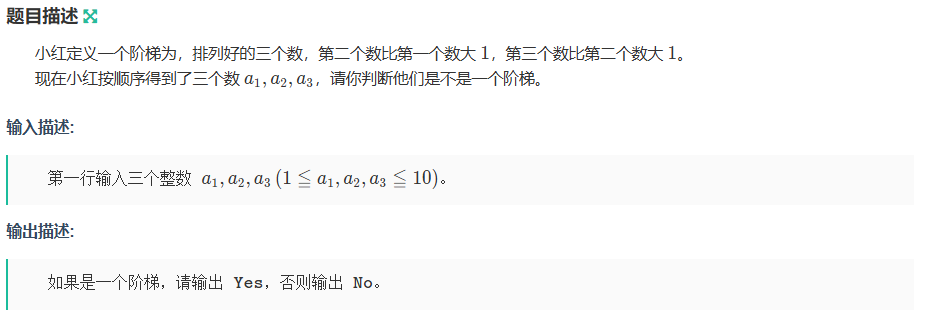

#include<bits/stdc++.h>
#define ll long long
#define endl "\n"
using namespace std;
void solve() {int x, y, z;cin >> x >> y >> z;if (x + 1 == y && y + 1 == z) {cout << "Yes" << endl;}else {cout << "No" << endl;}return;
}
int main(){ios::sync_with_stdio(false); // 禁用同步std::cin.tie(nullptr),std::cout.tie(nullptr); // 解除cin与cout绑定int t = 1;//cin >> t;while (t--) {solve();}return 0;
}小红的数组取数
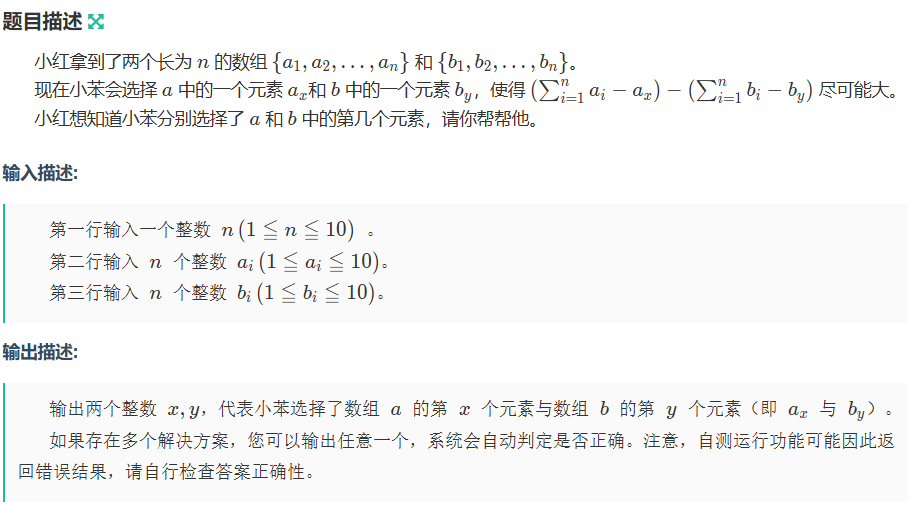
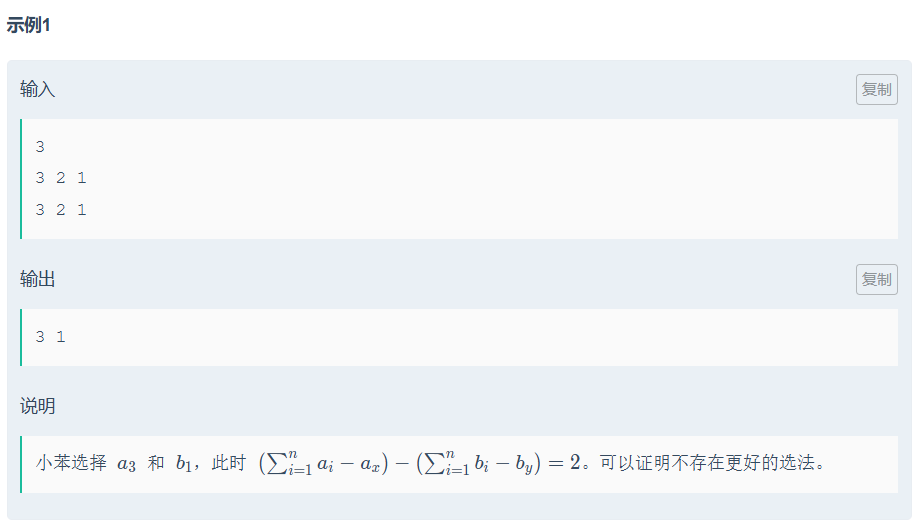
思路:
就是找a数组的最小值位置和b数组最大值的位置。
#include<bits/stdc++.h>
#define ll long long
#define endl "\n"
using namespace std;
void solve() {int n;cin >> n;vector<int>a(n), b(n);int min_a=INT_LEAST32_MAX, aj = -1;for (int i = 0; i < n; i++) {cin >> a[i];if (min_a > a[i]) {aj = i;min_a = a[i];}}int max_b = INT_LEAST32_MIN, bj = -1;for (int i = 0; i < n; i++) {cin >> b[i];if (max_b < b[i]) {bj = i;max_b = b[i];}}cout << aj + 1 << " " << bj + 1 << endl;return;
}
int main(){ios::sync_with_stdio(false); // 禁用同步std::cin.tie(nullptr),std::cout.tie(nullptr); // 解除cin与cout绑定int t = 1;//cin >> t;while (t--) {solve();}return 0;
}小红抽卡
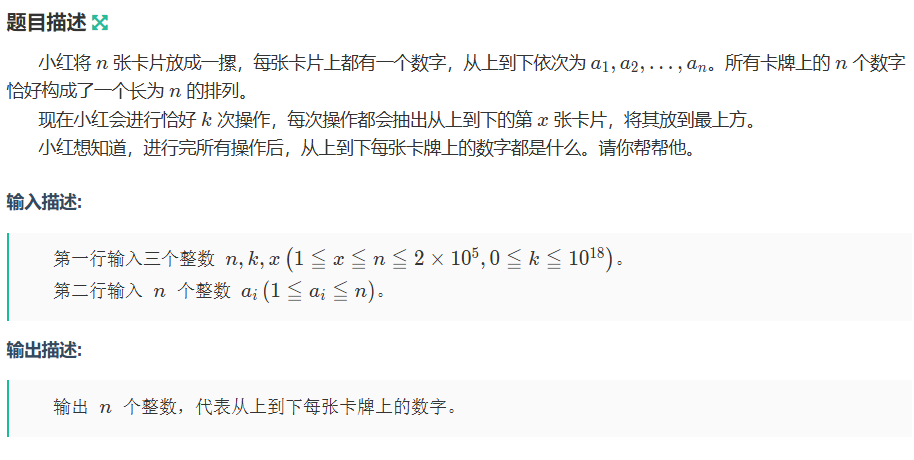
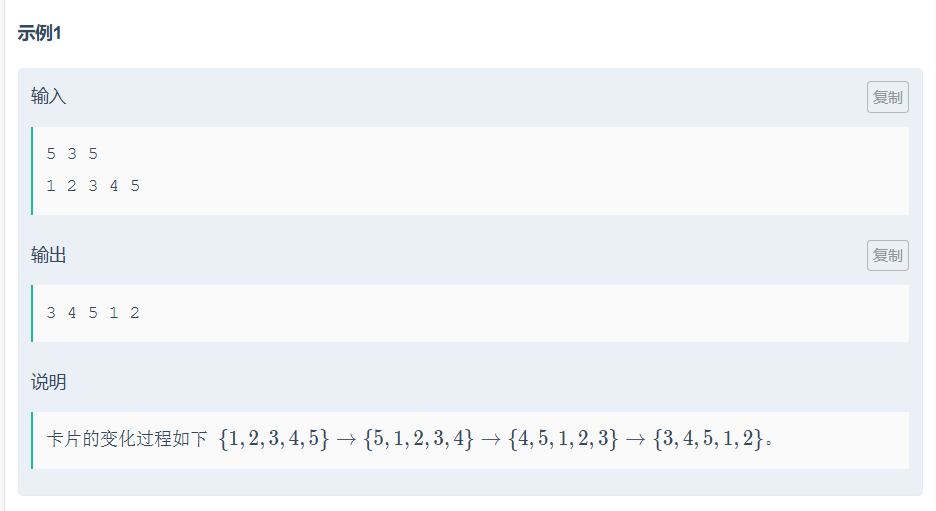 思路:
思路:
x以下的数位置不变,x以上的数循环向右移一位。
所以可以将k先%x;
然后(x-k+i-1) % x+1,就是i位移k次后对应的坐标(a[1]为首元素)
#include<bits/stdc++.h>
#define ll long long
#define endl "\n"
using namespace std;
void solve() {ll n, k, x;cin >> n >> k >> x;vector<ll>a(n+1);for (int i = 1; i <= n; i++) {cin >> a[i];}k %= x;for (int i = 1; i <= n; i++) {if (i <= x) {cout << a[(x-k+i-1) % x+1] << " ";}else {cout << a[i] << " ";}}cout << endl;return;
}
int main(){ios::sync_with_stdio(false); // 禁用同步std::cin.tie(nullptr),std::cout.tie(nullptr); // 解除cin与cout绑定int t = 1;//cin >> t;while (t--) {solve();}return 0;
} 小红的好数对 |
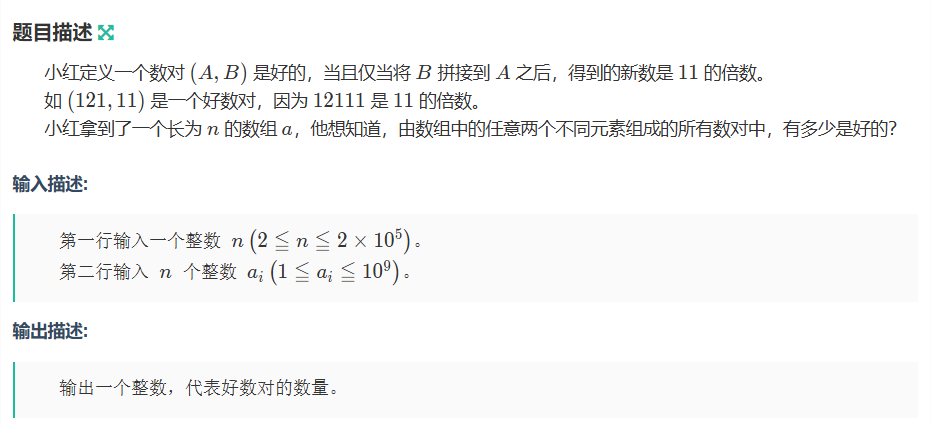

思路:
实现步骤
- 输入处理:读取数组并预处理每个数的模 11 结果及其不同位数下的模 11 结果(a[i]*10,a[i]*100……)
- 统计长度和模结果:使用二维数组 b 统计每个数的长度和模 11 结果的频率。
- 计算配对数量:遍历每个数,计算其作为 B 时满足条件的 A 的数量,注意避免重复计算和自配对。
- 输出结果:统计所有满足条件的数对数量。
-
预处理部分:
- 对每个数计算其模 11 的结果
a[i][0]。 - 计算其在不同拼接长度(1 到 9 位)下的模 11 结果
a[i][j]。 - 统计每个数的长度和模 11 结果的频率到二维数组
b中。
- 对每个数计算其模 11 的结果
-
配对条件检查:
- 对于每个数 B,计算其作为拼接后的数时需要的 A 的模 11 结果
required_mod。 - 查询
b数组中满足条件的 A 的数量,并累加到答案中。
- 对于每个数 B,计算其作为拼接后的数时需要的 A 的模 11 结果
-
结果调整:
- 减去自配对的情况
sum,确保只统计不同元素的配对。
- 减去自配对的情况
复杂度分析
- 时间复杂度:O(n * 9) = O(n),每个数处理 9 次,适用于大规模数据。
- 空间复杂度:O(n + 11 * 11) = O(n),预处理和统计数组的空间需求。
#include<bits/stdc++.h>
#define ll long long
#define endl "\n"
using namespace std;
void solve() {int n;cin >> n;vector<vector<ll>>a(n, vector<ll>(10)), b(11, vector<ll>(11));ll sum = 0;//记录能否与自己成对for (int i = 0; i < n; i++) {cin >> a[i][0];ll w = a[i][0];a[i][0] %=11;for (int j = 1; j <= 9; j++) {a[i][j] = a[i][j - 1] * 10 % 11;}int u = 0;ll o = 1;while (w > 0) {w /= 10;u++;o *= 10;}b[u][a[i][0]]++;if (a[i][0] * ((o + 1) % 11) % 11==0) {sum++;}}ll ans = 0;for (int i = 0; i < n; i++) {for (int j = 1; j <= 9; j++) {if (a[i][j] == 0) {ans += b[j][0];}elseans += b[j][11 - a[i][j]];}}cout << ans - sum << endl;return;
}
int main(){ios::sync_with_stdio(false); // 禁用同步std::cin.tie(nullptr),std::cout.tie(nullptr); // 解除cin与cout绑定int t = 1;//cin >> t;while (t--) {solve();}return 0;
}小芳的排列构造
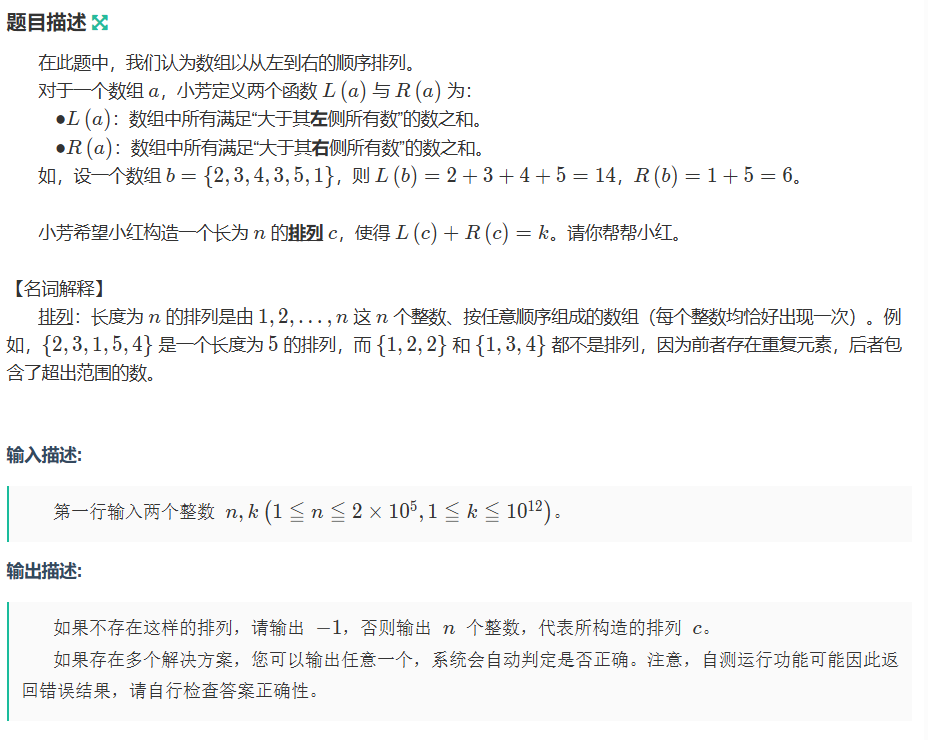
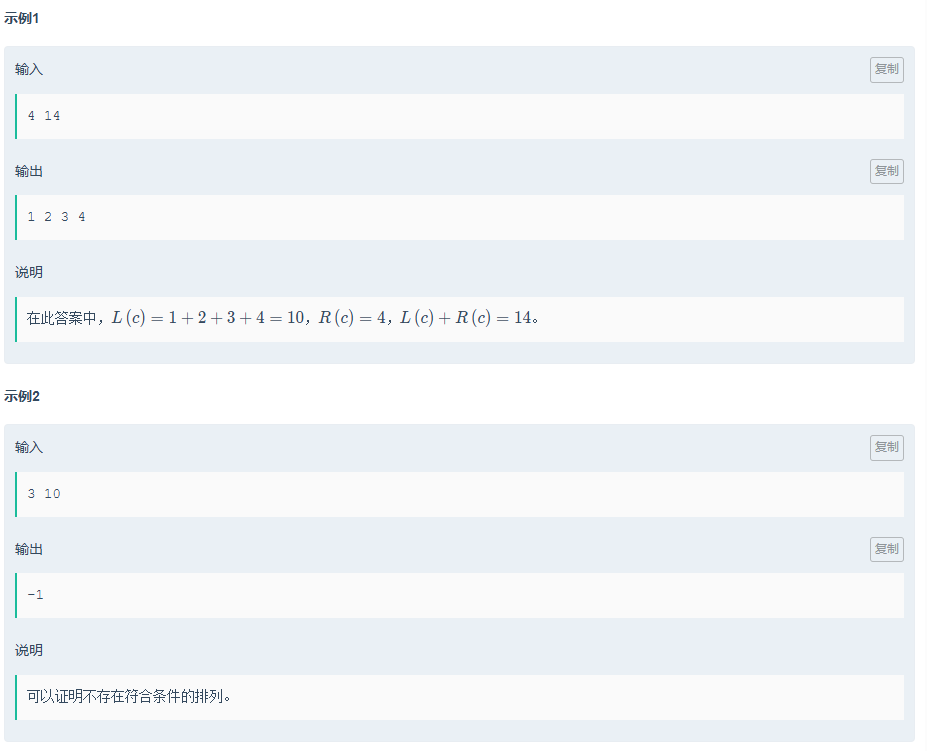
思路:
我可以发现L+R中 n必出现两次,n-1必出现一次,剩下的最多出现一次
所以n * (n + 1) / 2 + n < k||n*2+n-1>k 不存在
然后 就找出1——n-2组成n的一种方案然后从小到大排列放在最前端就ok,剩下的放在n-1——n之间
#include<bits/stdc++.h>
#define ll long long
#define endl "\n"
using namespace std;
void solve() {ll n;ll k;cin >> n >> k;if (n == 1) {if (k == 2) {cout << 1 << endl;}else {cout << -1 << endl;}return;}vector<int>a(n + 1, 0);if (n * (n + 1) / 2 + n < k||n*2+n-1>k) {cout << -1 << endl;return ;}a[n] = 2, a[n - 1] = 2;k -= n * 2 + n - 1;int u = n - 2;while (k > 0) {if(k>u){k -= u;a[u--] = 1;}else {a[k] = 1;break;}}for (int i = 1; i <= n; i++) {if (a[i] == 1) {cout << i << " ";}}cout << n - 1 << " ";for (int i = 1; i <= n; i++) {if (a[i] == 0) {cout << i << " ";}}cout << n << endl;return;
}
int main(){ios::sync_with_stdio(false); // 禁用同步std::cin.tie(nullptr),std::cout.tie(nullptr); // 解除cin与cout绑定int t = 1;//cin >> t;while (t--) {solve();}return 0;
}小红的排列构造
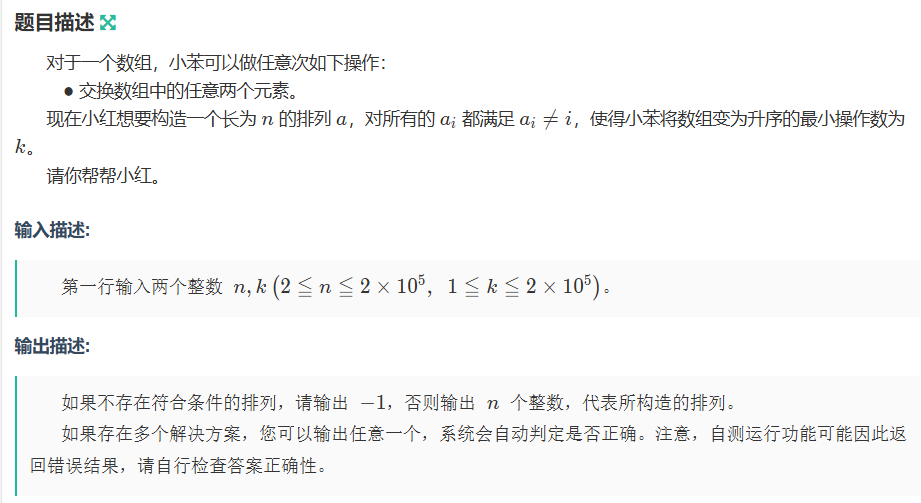
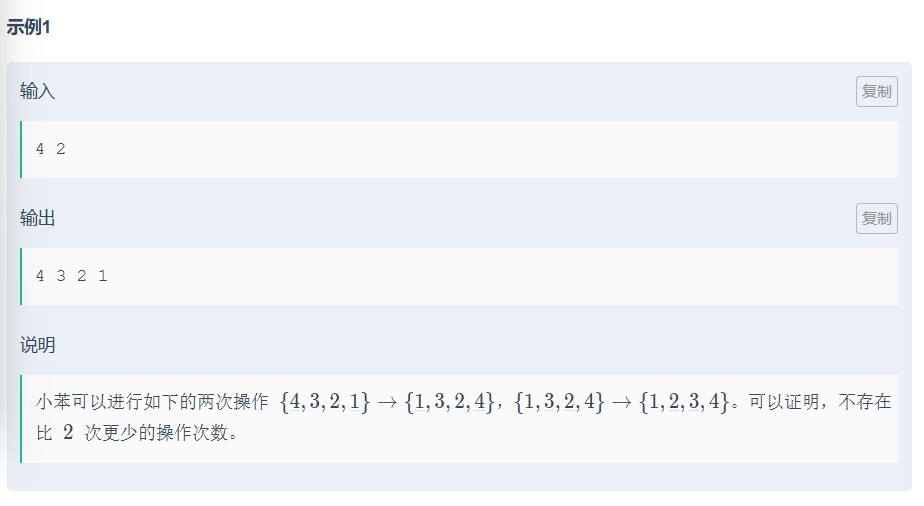
思路:
这就有点相当与选择排序吧,将a[i]于j互换位置(a[i]==j),所以他最多就n-1步,最少是(n+1)/2步
关键观察
最小交换次数等于排列中环的个数减去1。对于排列a,可以将其分解为若干不相交的环。每个环需要至少(环长度-1)次交换才能将元素归位,总交换次数为n - c,其中c是环的个数。
因此,为了得到恰好k次交换,需要满足:
- k = n - c
- c = n - k
即排列必须恰好由(n - k)个环组成。
构造方法
-
无解条件:当k ≥ n或k < ⌈n/2⌉时无解。因为:
- 最少交换次数为n - c,其中c ≤ n/2(因为每个环至少2个元素)。
- 最大交换次数为n - 1(当排列本身是一个大环时)。
-
构造排列:
- k = n - 1:排列为一个n元环,例如[2, 3, ..., n, 1]。
- k = ⌈n/2⌉:排列为尽可能多的2元环,例如[2, 1, 4, 3, ..., n, n-1](当n为偶数时)。
- 其他情况:通过调整环的数量和大小来满足c = n - k。
代码实现思路
- 检查k是否在有效范围内。
- 根据k的值构造对应的排列:
- 当k = n - 1时,构造一个n元环。
- 当k = ⌈n/2⌉时,构造尽可能多的2元环。
- 其他情况,通过合并或拆分环来调整环的数量。
代码修正
提供的代码中:
- 当k = (n + 1)/2且n为奇数时,构造了一个特殊情况。
- 其他情况构造了一个n元环,并通过交换调整环的数量。
需要确保构造的排列满足:
- 无固定点(a_i ≠ i)。
- 环的数量c = n - k。
注意事项
- 确保构造的排列无固定点。
- 环的数量必须精确控制为c = n - k。
- 当n为奇数时,可能需要特殊处理最后一个元素。
#include<bits/stdc++.h>
#define ll long long
#define endl "\n"
using namespace std;
void solve() {int n, k;cin >> n >> k;if (k >= n || k < (n + 1) / 2) {cout << -1 << endl;return;}vector<int>a(n + 1);if(n%2==1&&k==(n+1)/2){for (int i = 1; i <= n; i++) {a[i] = n - i + 1;}swap(a[n / 2], a[n / 2 + 1]);}else {for (int i = 1; i <= n; i++) {a[i] = i + 1;}a[n] = 1;k = n - k - 1;for (int i = 2; i <= n && k > 0; i += 2) {swap(a[i], a[n]);k--;}}for (int i = 1; i <= n; i++) {cout << a[i] << " ";}cout << endl;return;
}
int main(){ios::sync_with_stdio(false); // 禁用同步std::cin.tie(nullptr),std::cout.tie(nullptr); // 解除cin与cout绑定int t = 1;//cin >> t;while (t--) {solve();}return 0;
}